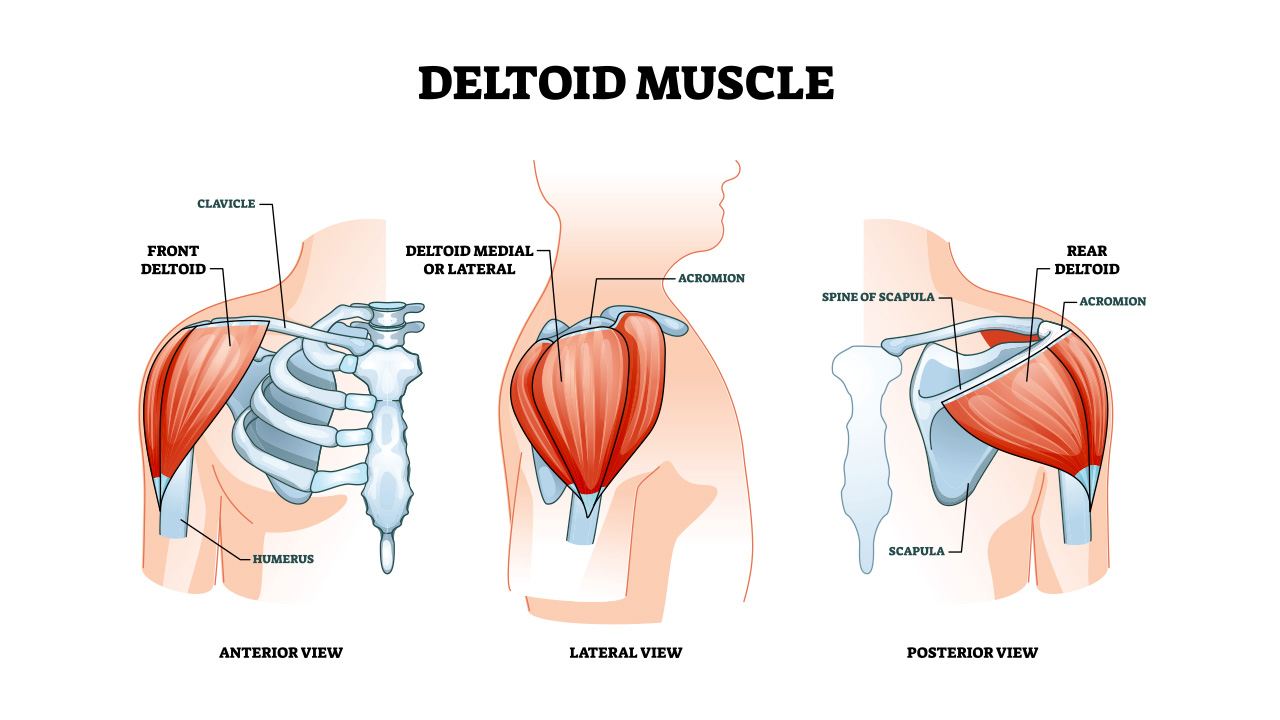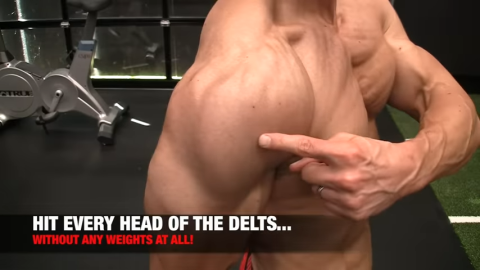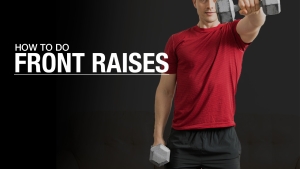
HOW TO BUILD THE REAR DELTS
I’m going to show you the fastest way to build your rear delts.
And here’s where I’m going to make it interesting: You won’t be doing the Rear Delt Fly.
I know it sounds crazy because every trainer and coach you know uses them, right?
As far as shoulder exercises go, there’s nothing wrong with the motion of the Rear Delt Fly. We know the function of the rear delt is to get that arm back, behind the body.
However, if you always try to activate your rear delts in the straight arm fashion that comes with the territory of the Rear Delt Fly, then you’re limiting the amount of potential activation.
When you limit the capacity of the rear delt to perform the lift, you’re missing out on gains, and no one wants that.
I’m going to outline why you need to be more creative with your rear delt training and how to do just that. I’ll also provide some rear deltoid exercises that will help you get stronger shoulders.
ANATOMY OF THE DELTOID MUSCLES
As always, guys, I want you to focus on building a stronger mind-to-muscle connection throughout the shoulder muscles.
This ensures the optimal level of muscle engagement during each of the exercises I’ll cover.
By doing so, you’ll be able to gain a comprehensive understanding of why such exercises are so advantageous and how they should be performed for the greatest results and overall shoulder health.
In this case, you’re going to learn about the shoulder muscles. In particular, I’ll review the deltoids muscle group, which is made up of three heads or sections:
- Anterior deltoids (front delts)
- Lateral deltoids (side delts)
- Posterior deltoids (rear delts)
All three heads of the deltoid muscle work together seamlessly to help you move the shoulder and arm, yet each has its own unique ability, which contributes to you performing upper body movements.
Let’s take a closer look at each:
POSTERIOR DELTS (REAR DELTS)
The rear deltoid muscle, also known as the posterior deltoid, is located on the back of the shoulder and it originates from the scapula and inserts onto the humerus bone of the upper arm.
There are three primary functions of the rear deltoid muscle:
- Shoulder extension: The movement of the arm backward from the front of the body. To feel shoulder extension, move your arm behind you in an upwards motion.
- Shoulder horizontal abduction: The movement of the arm away from the midline of the body.
- External rotation of the shoulder: The movement of the arm away from the body while the elbow is kept at the side.
In addition to these primary movements, the rear deltoid also contributes to activating numerous upper-body muscles through pulling movements such as Pull-Ups, Face Pulls, and Rows with cables.
When performing these exercises, the rear deltoid works in conjunction with other muscles of the back and arms to help stabilize and move the shoulder joint.
LATERAL DELTS (SIDE DELTS)
The lateral deltoid muscle, also known as the middle deltoid, is located on the side of the shoulder. It has three primary functions:
- Shoulder abduction: The movement of the arm away from the midline of the body
- Shoulder flexion: The movement of the arm forward
- Shoulder horizontal abduction: The movement of the arm away from the body while the elbow is kept at the side
In addition, the lateral deltoid also contributes to upper body pressing movements such as Overhead Presses and Incline Dumbbell Presses.
Strong lateral deltoids are important for improving overall shoulder strength and appearance. We might not immediately recognize them as “mirror muscles,” but they contribute significantly to the width and definition of the shoulder muscles.
You can target the lateral delts with exercises like Dumbbell Rear Lateral Raise Sets to stimulate muscle growth and impressive muscle mass.
ANTERIOR DELTS (FRONT DELTS)
The anterior deltoid muscle, also known as the front deltoid, is located on the front of the shoulder. It originates from the collarbone and inserts onto the humerus bone of the upper arm.
The primary function of the anterior deltoid muscle is to perform shoulder flexion, which is the movement of the arm forward.
It also assists with the following movements:
- Shoulder horizontal adduction: The movement of the arm toward the midline of the body
- Shoulder internal rotation: The movement of the arm inward toward the body
Naturally, the anterior deltoids help with other upper body pressing movements such as Push-Ups and Bench Presses. It also assists with overhead movements like a Shoulder Press.
Some exercises that can help to target and strengthen the anterior deltoid include Front Raises, Dumbbell Raises, and heavy Bench Presses.
BENEFITS OF TRAINING THE REAR DELTS
When it comes to shoulder training, the rear deltoid muscle often gets overlooked.
However, training this muscle is crucial for achieving well-rounded shoulder development and improving overall upper body strength.
Let’s explore the hefty benefits of training the rear deltoid muscle and how posterior shoulder development can help with performance.
IMPROVED POSTURE
The rear deltoid muscle plays a critical role in maintaining good and proper posture.
It helps to counterbalance the forward pull and potential muscle imbalances such as rounded shoulders and a hunched back caused by the front deltoid muscle.
Strengthening the rear deltoid muscles can help to keep the shoulders back and down, improving overall posture and reducing the risk of shoulder injuries.
INCREASED SHOULDER STABILITY
The rear deltoid muscle is also important for maintaining shoulder stability. It helps to support the shoulder joint, reducing the risk of impingement and other shoulder injuries.
The posterior deltoid is often a one of the most common muscle weaknesses. This is why it’s so important to take a moment to recognize that it belongs in your workouts.
Strengthening the rear deltoid muscles can help to improve overall shoulder strength and stability, making it easier to perform activities that require strong and stable shoulders.
IMPROVED ATHLETIC PERFORMANCE
Posterior shoulder strength is essential for athletes who engage in activities that require upper body strength during throwing as well as push movements and pull movements.
For example, football players need strong rear deltoids to throw the ball with power and accuracy, while swimmers need strong rear deltoids to pull themselves through the water with speed and efficiency.
Strengthening the rear deltoid muscles can help to improve overall athletic performance in these and other activities.
BETTER AESTHETIC APPEARANCE
Training the rear deltoid muscles can also help to improve the aesthetic benefits of the shoulders.
Well-developed rear deltoids can give the shoulders a more defined and three-dimensional look, adding width, thickness, and overall balanced development to the upper back muscles.
This can be particularly beneficial for bodybuilders and fitness enthusiasts who are looking to achieve a well-rounded and aesthetically pleasing physique.
WHY REAR DELT FLYES FALL SHORT
While Rear Delt Flyes are a popular exercise for targeting the rear deltoids, they are not always the best option when it comes to building strength and size in this muscle group.
Before you pick up a pair of dumbbells to perform the Rear Delt Fly, you might want to trade it in for a variety of exercises that are better equipped to get the job done. Here’s why:
INFERIOR PLANE OF MOTION
When you perform a Rear Delt Fly, you’re moving through horizontal abduction.
This is not one of the best angles to train the rear delts because you don’t get maximum shortening of the rear delt muscle.
What you want to do instead is focus on moving through transverse extension.
In other words, your goal is to achieve an extension of the arm back and behind the body.
LACKS EXTENSION AND CONTRACTION
When you perform the Rear Delt Fly, you are utilizing an extended straight arm.
This means that you are anatomically limiting the amount of extension that your humerus – or upper arm – can get behind your body.
If you change the position and put more than just a slight bend in the elbow, you’re able to keep going back to achieve much more extension.
As a result, this means a better contraction on the rear delt muscle.
CAN’T GO HEAVY
The rear delt, like the middle and front delt, has a high capacity to handle some heavy dumbbells and a serious load of weight.
It’s not the weak link that it’s made out to be where people think it can only handle five pounds during a Bent-Over Dumbbell Reverse Fly.
Not even close! Guys, delts are powerful muscles with a high capacity for strength – you just need to give the muscle a chance to use that ability.
But when you do a Straight-Arm Reverse Fly, you’re extending the elbow and dramatically inhibiting its ability to lift any type of weight.
Lighter weights feel heavy when you extend your arm out like that.
Instead, what we want to do is get into a bent arm set-up.
WRONG HANDLE
One of the best ways to get into a bent arm set-up is with the classic back exercise, the Seated Row.
However, when you turn the Seated Row into a more rear delt-focused exercise, you might end of making one of the most common mistakes: you opt for the wrong handle and handle positions.
If you use a standard barbell handle or a triangle bar handle, you’re limiting how far back you can get.
So, what you want to do is utilize the long bar attachment.
That’s what’s going to get us the best effect because the long bar allows us to grab out wider, which will take our arms away from our body, out of adduction.
ELBOWS ARE TOO CLOSE
If you opt to perform rear delt-focused Seated Rows, there’s one more mistake you want to avoid: the positioning of your elbows.
The tighter to your side your elbows are, the more activation will happen in your lats, not your rear delts.
The way we want to get our rear delt to take over and do as much of the work as possible is to get those elbows out high.
Again, use the long bar attachment, focusing on contracting and squeezing the rear delts as you pull behind your body.
BEST EXERCISES FOR REAR DELTS
Just because you can’t see the rear delts doesn’t mean you don’t need to develop them.
If you’re going to focus on the rear delts, you have the option to see a lot faster growth if you stop doing the Rear Delt Fly and the Bent-Over Dumbbell Reverse Fly.
There are other rear delt movements that are much better suited to help you achieve your goals of deltoid muscle definition, growth, and strength gains.
SEATED REAR DELTOID ROWS

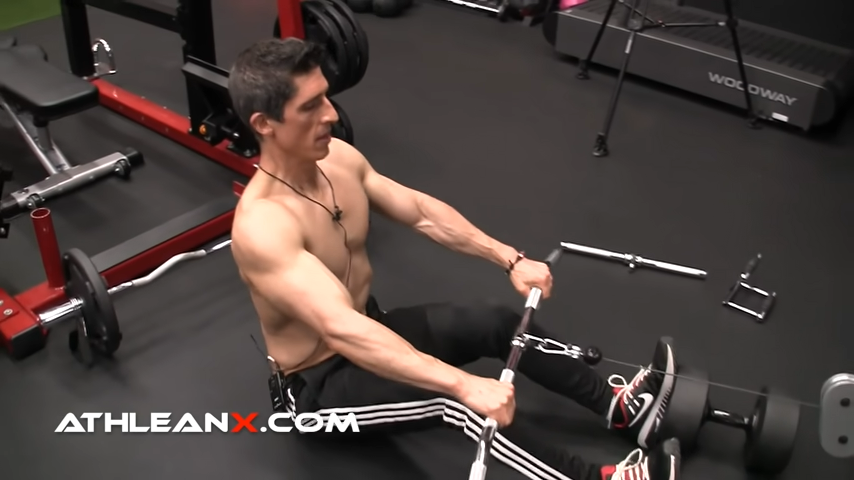
HOW TO PERFORM THE EXERCISE: The demonstration of this hybrid exercise shows you how to do this if you only have access to a cable machine. With that said, you can follow the same set-up and form on a traditional Seated Row machine. For either variation of the exercise, the key is to use the long bar attachment. Sit up nice and tall with arms are out wide. Focus on trying to get the upper arm back as far behind our body as possible. The elbows are high as you pull the long bar back. Be sure to maintain a tight core and upright posture throughout the movement. If you’re going for size, do not use a light weight! Use heavy weights with strict form and stay within the muscle building rep ranges of 8 to 12 repetitions.
WHAT MAKES IT EFFECTIVE: No doubt, this exercise will build your rear delts as fast as possible because you’re able to load it appropriately. Since the load is substantially higher than what you’ve probably used on the rear delts, you’re going to see some quick increases both in the strength and size of the rear delt.
STANDING REAR DELT ROW

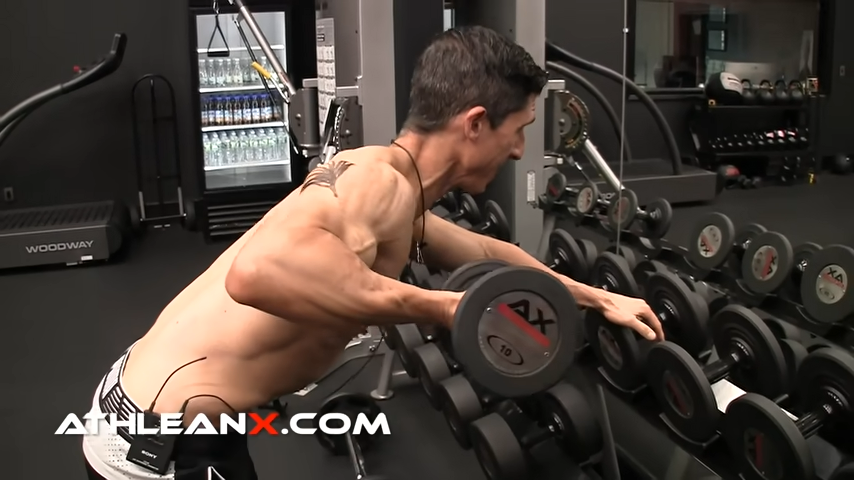
HOW TO PERFORM THE EXERCISE: While I did just mention avoiding lighter weights for the Seated Row exercise, this is one of the Rear Delt Fly variations where a light weight will serve you well. Grab a pair of dumbbells that are on the lighter side. Lean forward on a rack or an adjustable bench that is in an incline setting. You could do this on a flat bench, but I think you’ll get the most out of it on an incline bench. Bend over so you’re able to work against gravity and target the muscle. Perform a high raise, angling the elbow away from the body. As you come up, supinate the forearm with a goal of externally rotating the shoulder. Get up to the top, lift, pull, and squeeze.
WHAT MAKES IT EFFECTIVE: By externally rotating your arm and extending the elbow behind your body, you will be able to target the rear delts with precision. This is a great exercise for anyone interested in building muscle and strength in the shoulders.
REAR DELTOID PULLDOWN

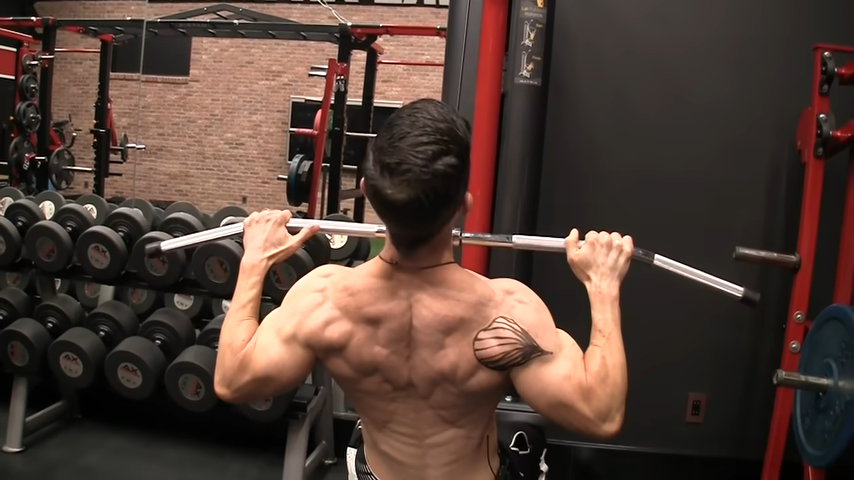
HOW TO PERFORM THE EXERCISE: This is a pretty straightforward exercise that will feel familiar if you’re a fan of the Lat Pulldown. It’s also one of my go-to moves for rear delts. Grab the bar on a Lat Pulldown machine with an overhand grip just outside of shoulder width. Lean back a bit, keeping tension on your core muscles, and then let the elbow travel back behind the body. Focus on contracting and squeezing the rear delts. This is going to look a lot like the Seated Rows from above. Since you are leaning back, you’re able to use heavier weights here.
WHAT MAKES IT EFFECTIVE: You are targeting the rear delts in the same way as the Seated Rows, focusing the movements in the transverse extension. Getting the elbows up and behind your body is going to hammer on the rear delt muscle.
UNDERHAND GRIP REAR DELT PULLDOWN

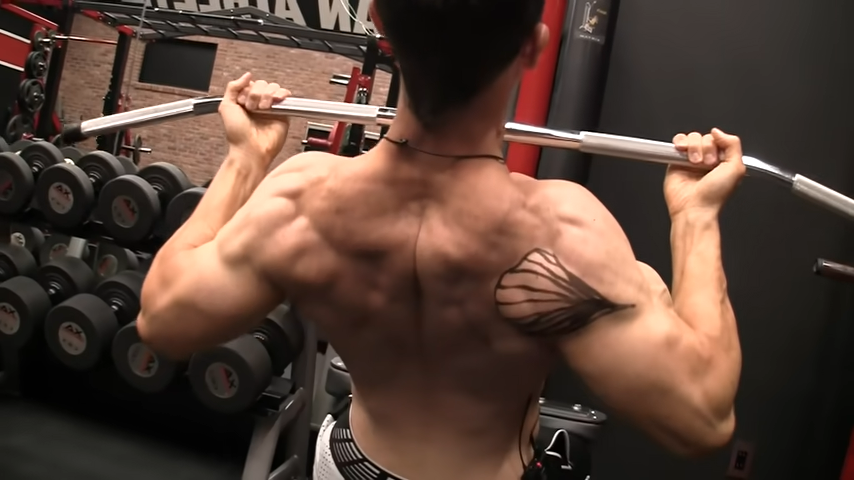
HOW TO PERFORM THE EXERCISE: This is just like the exercise above, but now you’re using an underhand grip. Again, grab the bar just outside of shoulder width, focus on core muscle engagement, and pull the elbows up and back.
WHAT MAKES IT EFFECTIVE: Given the form and underhand grip, you’ll feel the proper muscles activating from start to finish with this exercise. This exercise isolates the rear delts in a way that will provide an intense muscle contraction. Be sure to include this into any effective exercise routine.
ONE-ARM REAR DELT ROW


HOW TO PERFORM THE EXERCISE: You can alter the typical weight training exercise for bigger lats to make it focus on the rear delts. All you have to do is follow proper exercise technique when performing this variation of the Dumbbell Row. Instead of keeping the elbow tucked for all your sets, you want your elbow to drift out to the side. If you keep your elbow tight to your body, that’s going to be more effective for the lats. Allow the elbow to go out to the side and as it does, you lift and turn just a little to activate the rear delt.
WHAT MAKES IT EFFECTIVE: By lifting the elbow out and turning it with perfect form, you’re able to focus the contraction on the rear delt instead of the lats.
Stop ignoring the oft-neglected muscle, the rear deltoid.
It matters just as much as all the other ones, and it balances out your physique.
Make sure you’re using the best moves for rear delts, incorporating them into your weekly exercise program.
If you don’t currently have a strength training workout, we’ve got you covered. Check out our ATHLEAN-X programs to see which is the best fit for your goals and fitness level!

- There’s no doubt that Rear Delt Flyes provide a great exercise for those looking to strengthen their posterior deltoids. With that said, relying on this exercise alone limits rear delt activation, contraction, and results.
- When you perform a Rear Delt Fly, it is important to bear in mind that horizontal abduction only starts the motion but doesn’t provide enough extension and contraction of the muscle. To optimize your training session, focus on transverse extension, as this will enable full range of motion for maximum development.
- When you carry out the Rear Delt Fly, you have to keep your arm extended but this limits the extension of your arms. If you slightly alter the position by bending your elbow, you’ll be able to extend even further; ultimately causing a more intense contraction of your rear delt muscle!
- The rear delt is incredibly powerful and can lift some seriously heavy weights. However, a Rear Delt Fly exercise drastically reduces its capacity. Getting into a bent arm set-up will allow you to use heavier weights.
- Some of the best rear deltoid exercises you should incorporate into your workout program include the following: Seated Rear Deltoid Rows, Standing Rear Delt Rows, Rear Deltoid Pulldowns, Underhand Grip Rear Delt Pulldowns, and One-Arm Rear Delt Rows.
- To build up the size and strength of your rear delt muscle, focus on a foundation of complex compound movements, mixing in an isolation movement or two from the list above.
REAR DELT FLY FAQ
The rear delt fly exercise primarily works the rear deltoid muscle, which is located on the back of the shoulder.
Additionally, it can also work other nearby muscles of the upper back, such as the rhomboids and trapezius, but it does so to a lesser extent.
Here's a step-by-step guide on how to perform the rear delt fly exercise for someone who is new to fitness:
- Begin by standing with your feet shoulder-width apart and holding a pair of dumbbells in your hands with your palms facing inward.
- Bend your knees slightly and lean forward from the hips until your torso is at a 30- to 45-degree angle. Keep your back straight and your head in a neutral position.
- With your elbows slightly bent, lift the dumbbells out to the sides until your arms are parallel to the ground. Make sure to keep your shoulders relaxed and avoid shrugging them up towards your ears.
- Hold this position for a brief moment, then slowly lower the dumbbells back to the starting position.
- Repeat the movement for a desired number of repetitions.
It's important to note that when performing the rear delt fly exercise, it's important to use a weight that is appropriate for your fitness level and to maintain proper form throughout the movement.
Avoid swinging the dumbbells or arching your back, as this can put unnecessary strain on your lower back and increase the risk of injury.
Start with a light weight and gradually increase the weight within reason as you become more comfortable with the exercise. If you feel the Rear Delt Fly isn’t providing enough stimulus, try one of the exercises from above.
Here’s how to grow the size of your rear delts:
First, start with complex compound exercises in your workout routine such as Rows, Pull-Ups, And Chin-Ups. These exercises involve multiple muscle groups, including the rear deltoids.
After you’ve hit the rear delts in your normal strength training workout, now you can focus on using an isolated movement or two.
Isolation exercises like the ones I mentioned above target the rear deltoids specifically. These exercises can be performed using dumbbells, resistance bands, or cables (e.g., cable pulley or rope).
Next, I want you to focus on using progressive overload, which is the gradual increase of resistance over time. Guys, don’t just lift the same weight from workout to workout. Change it up and challenge yourself.
Finally, depending on your goals, you should vary your rep ranges. For example, performing high-rep sets of 12-15 reps can help to increase muscular endurance, while performing lower-rep sets of 6-8 reps can help to increase muscle size and strength.

Jeff Cavaliere M.S.P.T, CSCS
Jeff Cavaliere is a Physical Therapist, Strength Coach and creator of the ATHLEAN-X Training Programs and ATHLEAN-Rx Supplements. He has a Masters in Physical Therapy (MSPT) and has worked as Head Physical Therapist for the New York Mets, as well as training many elite professional athletes in Major League Baseball, NFL, MMA and professional wrestling. His programs produce “next level” achievements in muscle size, strength and performance for professional athletes and anyone looking to build a muscular athletic physique.
















